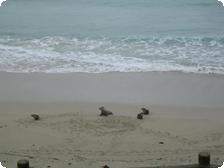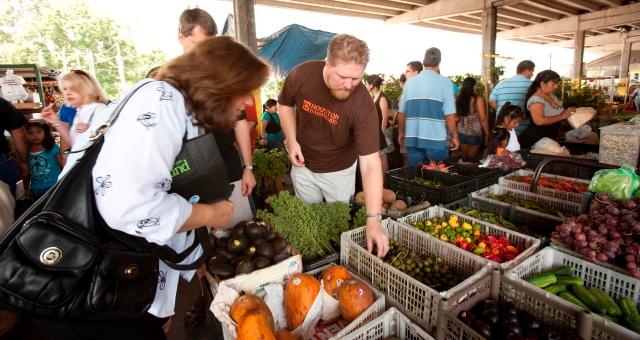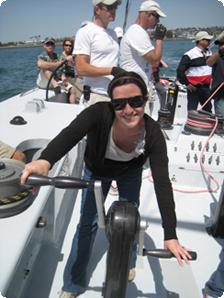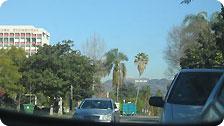Some say my destiny to explore and conquer Australia was set at my birth when my parents gave me the name “Sheila”. Sadly, the word is as common as kangaroo in the Aussie/Kiwi vocabulary.
After nearly 20 years tinkering with the idea of a trip Down Under, I set course for a two week adventure to explore and learn how the other Sheilas live. Unfortunately, I arrived during winter and the rainy season.
Wool coats, rain slickers, scarves and boots replaced the shorts and sandals I left behind in my native Florida. Despite the weather, the wharf was buzzing with activity. Passenger ferries, fishing dinghies, sail boats and water taxis dotted the waterway from every angle. But it is the Harbour Bridge and the famed Opera House that dominated the view.
In its present day grandeur, it is somewhat hard to imagine Sydney as a rustic outpost and a burgeoning 18th Century trading port. Although Sydney is recognized as the first European settlement in Australia (1770), the city is better known as the welcome center for England’s surplus convict population. Sadly, women and children were among the criminals transported to the new territory. At that time, stealing a loaf of bread was a crime punishable by life of imprisonment or hard labor. But history will show that many of these convicts were entrepreneurial spirits who soon became the founding fathers of the country. For most, Australia was a bountiful land of new beginnings.
My lodging, the Harbour Rocks Hotel, was a short walk from the Sydney harbor front. It is a small boutique hotel (55 rooms) nestled in the heart of the historic, and now trendy, Rocks precinct of Sydney. The area is a perfect location for those who want to experience a bit of the past and the present.
To appreciate the Rocks, one must understand its illustrious past. The Rocks Walking Tour is highly recommended. The tour guides are engaging storytellers and historians. Their vivid tales will transport you back in time. You will walk the maze of narrow streets and hidden alleyways and learn that this village was once considered the “Sewer of Sydney” – a place of death rather than life. It is said that one could “smell the Rocks long before entering.” Crowded tenement housing infested with rats and without running water has been replaced by fashionable government apartments, modern shops, restaurants and hotels. A special grant saved this colorful community from the wrecking ball. If you look closely, glimpses of the past can still be found in the sandstone. You will see unique markings on the stones of the buildings. These were a convict’s tally of his work for the day, like a time card that measured performance.
Leisa, my walking tour guide, shared with me some of the area’s favorite sailor watering holes. The Lord Nelson and the Hero of Waterloo, Sydney’s first taverns (note: there is still heated discussion on which establishment is older) are only a few blocks north of Argyle Street and are still popular local haunts. Stop in and partake in a pint – a favorite Aussie pastime.
Follow George Street from the Rocks and you will find retail nirvana.The big anchor department stores are David Jones (think Nordstrom) and Myer (a cross between Macy’s and Dillard’s). Shopaholics will be at home. A favorite for foodies is the David Jones specialty gourmet department where you will find some of Australia’s finest culinary and wine treasures.
A word from the now experienced…shop smart to save money. For any purchases totaling $300 or more at one store (with a receipt), you will get back the GST (tax). (Receipts from multiple stores do not count.) Before departing on your flight home, you can claim your refund at the airport (counters are located just after security). Getting money back is always a great way to end a vacation.
The Queen Victoria Building and the Strand Arcade are shopping meccas encased in history. The Queen Victoria Building (QVB), a stunning Romanesque-style landmark, dates back to 1898. Although formally erected as a monument to the reigning monarch, it served a more critical role as a government project designed to boost the economy by providing work to jobless craftsmen and laborers. Today, it is a bustling retail center that caters to the desires of discerning consumers with three levels of shops, restaurants and cafes. The Strand, a short walk from the QVB, is a true Victorian promenade, which continues to showcase Sydney as a world center for style and design. Here you will find an eclectic mix of shops featuring Australia’s top designer labels, jewelry, giftware and more.
Break from shopping and take in a 360 degree city view from the top of the Sydney Tower. The vantage point from the observation deck is truly amazing. Map out your next tour stop from 820 feet above the ground, such as Darling Harbour, a popular entertainment hub. It is a short water taxi ride from Sydney’s Circular Quay or a 20 minute walk from the city center shopping district. Restaurants, more shopping, and some of Sydney’s favorite attractions can be found here.
Sydney’s Wildlife World, home to more than 130 of Australian animal species, was my top pick. A hands-on encounter with a kangaroo and koala is part of the experience.
Right next door, a visit to the Great Barrier Reef awaits at the Sydney Aquarium. The exhibit is an exhilarating underwater theater of over 12,000 species. I spent hours mesmerized by the colorful schools of fish dancing across the clear glass viewing panels. Sharks, stingrays, and turtles – in all shapes and sizes – join each repertoire, leaving you in awe of nature’s harmonious performance.
A morning in Sydney is not complete without a walk in the park. Sydney’s Royal Botanical Gardens are located just beyond the Opera House. When I ventured out for my early exploratory hike, my expectation was only to get in a little exercise before my scheduled tours. But my visit to the gardens far exceeded anything I could have imagined. Hands down, the Royal Botanical Gardens received my “wow” rating, which is not an easy accolade. While walking the expansive grounds (75 acres), I stopped in my tracks at the site of a tree covered in bats. Yes, bats. Hundreds of sleeping bats hanging from tree limbs like budding blossoms. I soon learned these bats, better known as Sydney’s flying foxes, are long-time permanent residents. It is reported that the first colony of the fruit loving bats in Sydney dates back to 1850. On any given day, thousands can be found roosting in the sheltered groves of the gardens. But be forewarned, at dusk these sleeping creatures wake to begin a feeding frenzy and fill the evening skies.
On my last day in Sydney, I felt it was time to test out my sea legs. I joined Captain Cook Cruises for a narrated highlights tour of the area. I opted for the All Day Explorer Pass, which covered all the major sights and provided a full day of on and off privileges without an additional cost.
Watsons Bay, Australia’s oldest fishing village, is among the cruise’s stops that deserves a longer visit. For a hearty plate of fish and chips, pop into Doyle’s family restaurant, famous for catching and serving seafood since 1885. Follow lunch with a climb to Watson Bay Gap for stunning views of jagged coastal cliffs and the Pacific Ocean. For those sun bathers who prefer to be free of tan lines check out Lady Bay, the local
nudist beach.
Bidding farewell to Sydney, I set out on my overland train adventure on the legendary Indian Pacific Rail Line, which has carried passengers coast to coast, Sydney to Perth, for over 39 years. Early February 2010 marks the train’s 40th anniversary. A feeling of déjà vu clouded my thoughts as I boarded. I felt transported back in time, channeling the life of an early settler in search of gold and happiness in the Australian outback. The full trans-continental journey now takes only a few days to cover nearly 3000 miles compared to the required weeks of travel of yesteryear. The hum of the wheels against the tracks creates a hypnotic lullaby. A moment, an hour, and a day can slip by without effort or thought.
Indulgences like an overnight sleeper cabin and full service white table cloth dining (Gold Kangaroo Service) make the trip a unique and unforgettable experience. You will never find a better front row seat to some of Australia’s most colorful landscapes. My travel itinerary would take me as far as South Australia to the lovely city of Adelaide, best known for its festivals, international flavor, and expansive parklands.
Wine enthusiasts will not want to miss a visit to the National Wine Centre, just at the end of North Terrace in Adelaide. The building, inside and out, celebrates Australia’s wine industry. Interactive displays test your knowledge of grapes and the wine-making process. Informed and inspired, you are prepared to take on the Barossa Valley wine country, a short 20 minute drive from the city.
Avoid the need for a designated driver by pre-booking a tour. Prime Mini Tours offers small, affordable and personable full day excursions with lunch for under 100 USD. Most tours will make up to five designated stops. Visiting every vineyard may require a private customized tour and will take several days.
The rich history of South Australia reaches beyond the vineyards and the first settlement of Adelaide in the early 1800’s. The Aboriginal culture and spirit remains an integral part of authentic Australian life. The folklore, magic and mysteries resurrected in Aboriginal traditional story-telling or dreaming come to life in the South Australia (SA) Museum. The museum is home to the largest collection of Aboriginal artifacts in the world.
A short walk behind the SA Museum building, you will find a beautiful courtyard leading to the entrance of another must-see attraction – the Migration Museum. Commemorative bricks etched with family names and dates celebrate the courage and vision of Australia’s early European settlers. The South Australia immigration story is not unlike the U.S. Ellis Island account with a few daunting and unfathomable government policies, which remain buried to the public eye. A time line marks key arrivals. The Aborigines were first, followed by the British and French explorer invasion. The dramatic population peaks and valleys are evidence of Australia’s sporadic efforts to “populate or perish”.
In the early 1800’s, gold was the lure for immigration. Later it was the promise of land grants and assisted passage. By the late 19th century and after the war, the country had to compete with the United States and Canada for migrants. Sadly, the implementation of the White Australia Policy (1901) narrowed recruitment by encouraging immigration of only white nationalities and races, specifically, British and mainland Europeans.
Other applicants (Asians, Africans and Islanders) were blatantly excluded and denied entry via controlled discriminatory practices. The notorious “Dictation Test” assessing the competency of a candidate by testing European language skills is wonderfully showcased in one of the museum’s many exhibits. Test your skill. Do you know the Dutch or Scottish/Gaelic translation for boat or town hall? If not, count yourself among the many who did not make the cut. By the end of WWII, over a million people moved to Australia from Britain. This surge in migration was the direct result of a post-war project fondly dubbed the “ten pound passage” scheme. The promotion comes alive in the vintage posters and fliers on display. The museum promises to open your heart and mind to Australia’s rich heritage that continues to flourish.
Rundle Street, Adelaide’s shopping and entertainment center, is a favorite people-watching hot spot for locals and tourist alike. It is on Rundle Street you will find a United Nation of dining options – Chinese, Thai, Italian, Greek, and some favorite local pub establishments. But to experience an authentic market, an early morning wake up call is advised. Adelaide’s Central Market is a bustling mecca of commerce where over 50 traders can be found on any given day. After market, head west a few blocks and you will find solace in dim sum or a delectable seafood dish in Adelaide’s very own Chinatown.
Only a few hours south of Adelaide, is the world renowned Kangaroo Island (KI), a naturalist’s paradise. The island’s rustic beauty and abundance of wildlife, often compared to that of the Galapagos, have made Kangaroo Island a treasured sanctuary. Over a third of the island is a protected conservation area or national park. The island’s topography is as diverse as its native plant and animal species. The land mass, just under 100 miles in length, is a mix of trees, bush, wetlands, beach, rock and sand. During a typical KI walkabout or tour, kangaroo sightings are plentiful. But the island is also home to wallabies (smaller versions of a kangaroo), spiny echidnas, New Zealand fur lions, Australian sea lions, lizards, and, of course, the cuddly Koala bears, among others. Be sure to bring binoculars or a zoom lens along to catch a close up of a Koala snoozing in the branches of a Eucalyptus tree.
Birding enthusiasts will be mesmerized by the island’s 267 species of birds. The little penguin, which lives along the rocky coast, shares the limelight with the kangaroo as a favorite tourist attraction. But it is the small yet mighty resident Ligurian Bee population that has made a mark on the world. The purest strain of this coveted Italian bee and some of the world’s finest honey can only be found on Kangaroo Island, such as Clifford’s Honey Farm or Island Beehive.
In addition to honey, the island is recognized as an innovative supplier of organic produce, sheep’s milk cheese (Island Pure Dairy), eucalyptus oil and soaps (Emu Ridge), lavender (KI Lavender Farm), fresh seafood, and other gourmet food items. SEALINK, South Australia’s premier KI tour operator, offers service by ferry from Cape Jervis, as well as, custom overnight packages. Given the year-round popularity of the destination, pre-booking a ferry reservation is advised.
My two full days of exploration only touched the surface of the island’s vast recreational and eco-tourism assets. I would strongly recommend at least a week for a full experience. There are accommodations to meet any taste and budget. I opted for the the Aurora Ozone Hotel in Kingscote, a lively little town on the coast not far from the island’s nightly penguin tour. The rooms were clean and the location central for coordinating day trips.
An Australian holiday would not be complete without a visit to Melbourne. Like Seattle, Portland and San Francisco, it is a city that is eclectic with a bohemian flair in its food, fashion, and nightlife. In Melbourne, coffee shops compete with pubs. On nearly every corner, you can find one or the other, or both. Sushi bars and noodle houses are not far behind in the competition. Melbourne is a true melting pot of arts and culture, where only Australian Rules Football outranks the Melbournian passion for food and the finer things in life.
The Citigate Hotel, offering affordable access and comfort, was my home base during my time in Melbourne. The city’s river walk area, a five minute walk from the hotel, is a pleasant escape from crowded streets and attractions. Restaurants, cafes, bistros and bars dot the river front. Take in an evening stroll or cruise on the Yarra River to enjoy the night lights of Melbourne’s skyline and the electric visual displays of nearby Federation Square. Lose yourself on foot during the day by exploring the city’s hidden alleys and arcades for shopping finds and tasty treats.
For the true adventurer, a ride on Melbourne’s city tram network with over 152 miles of track is a must. It has been ranked one of the top trolley rides in the world by National Geographic Magazine. You can spend days checking out over 1800 tram stops.
Be sure to stop off at St. Kilda, a nearby beach suburb, for the perfect weekend outing. At one time, St. Kilda was synonymous with prostitution and drug dealing; better known as Melbourne’s red light district. But over the years St. Kilda has enjoyed revitalization with an influx of upscale businesses and growing tourism demand.
The Esplanade Hotel, at the northern end of St. Kilda, offers fantastic views of the bay, a rich history and a vibrant social and music scene. For over 100 years, the hotel has been an entertainment icon. Today, it continues the legacy as a popular bar and venue showcasing bands nightly. The laughter and chatter of the crowds on the outside deck catch your attention immediately. I was easily drawn in by the comfortable and upbeat atmosphere. It is the perfect place to pop in for a beer and join in on the party.
Travel south to explore St. Kilda’s Acland Street, a historic street renowned for bakeries and pastry shops. Stop for a little wine and conversation at the Dogs Bar, a popular canine-friendly café. Here you find a more sophisticated and subdued artsy crowd. The food ranges from pizza to pastas with an excellent wine menu. Snag a table on the outside patio for prime seating.
Acland Street also boasts of St. Kilda’s first ultra-chic luxury hotel, The Prince, a small boutique property with a full service spa. Fashionistas and luxaholics will feel right at home enjoying a nightcap at Mink, the hotel’s exclusive vodka bar. For the backpacker crowd and a good game of pool, try the George Public Bar on Fitzroy, a popular late night haunt, just around the corner from The Prince.
My last few days, I ventured out beyond the metropolis to the open road, more specifically, Australia’s Great Ocean Road. The approximately 150 miles of scenic coastline starts about an hour southwest of Melbourne. The road is curved and rugged, reminiscent of California’s Pacific Coast Highway. Scenic lookouts offer stunning views of the expansive beach and the dramatic limestone and sandstone rock formations. Go West Tours brings the scenery and history of this destination to life in an entertaining and informative full day tour. The tour package includes pick-up from select Melbourne hotels.
The Great Ocean Road originated as a government work relief program created to provide jobs for returning soldiers. Upon its completion in 1932, the road was dedicated to both the living and the lost of World War I. A memorial arch marks the roadway near the inlet town of Aireys Inlet. Each stop along the way is rich in local color. Since the 1930’s, the small village of Torquay has been the popular haunt for surfers because of its close proximity to the iconic Bells Beach, home to 15 foot swells and world surf competitions.
However, it is Port Campbell National Park that ranks as the most visited Great Ocean Road attraction. The natural wonders along the park’s rocky coastline, such as Loch Ard Gorge, the Grotto, and the Twelve Apostles, are said to be millions of years old. Even the novice camera buff cannot resist the compelling need to capture the breathtaking beauty of these towering edifices. At sunset and sunrise, light dances off the face of the rocks creating a hallowed illuminated sky that is truly magical and unforgettable.
Since its day as a key shipping route for early colonies, this coastal stretch gave pleasure sharing its beauty and natural abundance. But pain and destruction were also prevalent. Many ships and their passengers met a tragic end on the rocks, giving the area the nickname of the “Shipwreck Coast”.
Beyond Port Campbell, near Apollo Bay, you will find a lush rainforest canopied by ancient trees. The Great Otway National Park is often compared to California’s Redwood Forest. Here you get glimpse into a garden of giant lush ferns, unique plant life, and myrtle beech trees that are nearing 300 years old. Otway Fly Walkway can take you to new heights when touring the park; it is the longest and highest walk of its kind in the world. The walkway reaches the tree line averaging over 100 feet. But not to fear, the walking tour experience is only an hour and under two miles.
Tales of discovery, hardship and adventure are weaved into the land, the water, and the wind. The vastness and diversity of the Australia landscape will continue to challenge and excite even the most avid explorer. But it is Australia’s youthful innocence as a nation (roughly 220 years younger than the United States) that will keep visitors deeply connected and coming back for more. I will dream as the native aboriginal people still do, contemplating my return to the Land of Oz.
************************
About the Author:
Sheila is a freelance writer who crosses countries and continents to connect with the people and places that inspire and reignite one’s passion for living. True to her gypsy heart, Sheila reinvents herself daily and follows her dreams. Storyteller, historian, entertainer and true soul sister – this travel diva can’t wait for her next gig. Did someone say “TV Talk Show Host” or perhaps “Cruise Director”?
Sheila’s successful media career spans 30 years and her published work continues to engage and enlighten readers around the world.




















